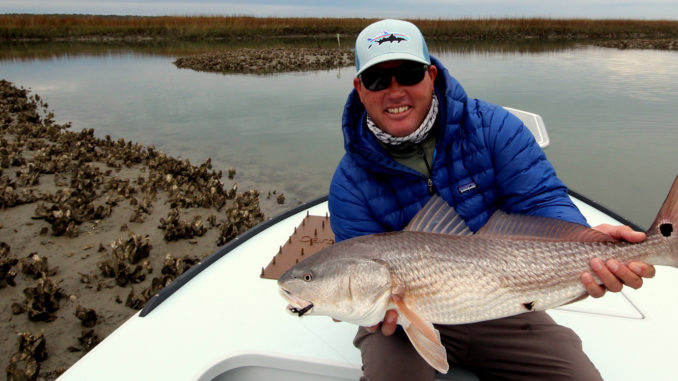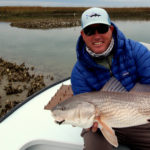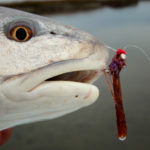
Clear March waters are prime for stalking reds
Sight-fishing is the pinnacle of inshore action for many anglers, and redfish are very suited to be the targets.
Stalking a redfish with rod in hand brings out something deeply imbedded in the fisherman; a primordial spark from eons ago. It is fishing, but also something more akin to stalking and hunting prey. We fish for fun, so the stakes are different, but in that brief moment when fish are spotted and a hooked offering sent forth, we are the Cro-Magnon, the hunter gatherer, a prehistoric version of ourselves, utilizing cunning and luck in hopes of survival. It is the desire for this connection to the distant past that drives more and more anglers to the sport of sight fishing instead of just baiting and waiting.
Luckily, modern anglers have more than sharpened sticks and dugout canoes available to them in the pursuit of reds. Shallow-running skiffs, graphite rods, polarized glasses and a myriad of flies and lures makes finding and catching reds a much easier task. But some days are better for sight-fishing than others, and planning ahead helps make the most of a day out sight fishing.
“Try to plan (for) a day with a mid-day low (tide), plenty of sunlight, and without a really big high tide,” said Capt. Chris Wilson of FinAddict Charters in Charleston.
The reasons are simple enough. Unable to disappear in the flooded grass, reds stay more concentrated and visible in shallow water, especially with plenty of sunlight giving them away.
Big tides aren’t always detrimental to spotting reds, either. While prime tailing action is usually experienced only in the warmer months, there is a bit of a dead time when the tide is out of the creeks but not yet on the tailing flats; for all-day action, a small high is best.
“Big tides offer more area for reds to explore, and they will scatter out and do their own thing,” Wilson said.
Another benefit to a day with a small high is they are often feature a low that is not all that low and rarely negative; that’s important, especially when searching for reds in creeks. Wilson said,
“On the minus tides, the reds are getting sucked out of the creeks due to low water and can become freaked out by having to move around a lot,” he said.
Another problem with a negative low is it greatly increases the risk of becoming grounded on oyster beds or sand bars. Running aground a couple of hours before dead low can result in a day spent feeding the sand gnats instead of the fish while waiting on the flood.
Once found, anglers need to use stealth when approaching reds; at no other time are reds more aware of their surroundings than when shallow. Hardly at the top of the food chain, reds constantly look out for what might eat them as much as what they might eat.
“Using a push pole is the best way to approach a school of redfish and keep your distance so you don’t spook them,” said Capt. Owen Plair of Bay Street Outfitters in Beaufort.
Once spooked, a school may scatter in all directions, or at least become very tight lipped. It is best to fall back and let the school settle down for a few minutes and regroup; it is definitely not the time to try harder and keep casting. It’s tempting with reds scattered everywhere, all within casting range, but patient anglers achieve success by waiting for the fish to “behave” before laying out another cast.
When it comes to offerings, both flies and lures work if presented correctly. Plair recommends trying to imitate minnows and other baitfish; a Redfish Magic spinnerbait comes to mind.
“March is when a lot of mullet and other bait start to move in, so flies and lures that imitate them work best,” Plair said.
Wilson, who prefers dark colors in the winter to imitate small shrimp and crabs, said, “Presentation is key, and you should match the hatch.”
When the weather warms, he’ll go with louder colors and noisier baits.
“The water is clear in the winter and dirty in the summer so when it is warm, I like to throw poppers or floating flies, like the EP floating everglades minnow, because the fish can feel it and find it in the muddy water,” he said. “Also, reds are much more aggressive in the warmer months and react better to loud baits.”
Live bait does not stay that way for long when presented in the proximity of hungry reds, but artificial lures and flies are a truer test of skill, and the satisfaction rendered by success is much greater. Carefully choosing the right offering and presenting it properly, skillful anglers often catch more than their bait-slinging counterparts; it is a case of helping art to imitate life, while at the same time connecting with something intangible, but buried deep within all of us nonetheless.





Be the first to comment